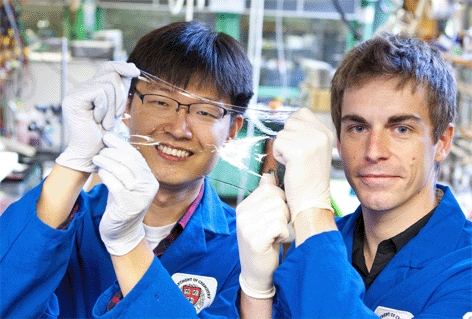A high-voltage signal that runs across its surfaces and through the layers forces the rubber to rapidly contract and vibrate, producing sounds between 20 hertz to 20 kilohertz.
Published in the August 30 issue of Science, the speaker is claimed to represent the first demonstration of electrical charges carried by ions that can be put to use in fast-moving, high-voltage devices.
‘Ionic conductors could replace certain electronic systems; they even offer several advantages,’ said co-lead author Jeong-Yun Sun, a postdoctoral fellow at the Harvard School of Engineering and Applied Sciences (SEAS).
According to Harvard University, ionic conductors can be stretched to many times their normal area without an increase in resistivity, a problem common in stretchable electronic devices. Secondly, they can be transparent, making them suited for optical applications. Thirdly, the gels used as electrolytes are biocompatible, so it would be relatively easy to incorporate ionic devices - such as artificial muscles or skin - into biological systems.
Signals carried by charged ions allow neurons to share knowledge and spur the heart to beat and bioengineers are keen to couple artificial organs and limbs with that system.
‘The big vision is soft machines,’ said co-lead author Christoph Keplinger, who worked on the project as a postdoctoral fellow at Harvard SEAS and in the Department of Chemistry and Chemical Biology. ‘Engineered ionic systems can achieve a lot of functions that our body has: they can sense, they can conduct a signal, and they can actuate movement. We’re really approaching the type of soft machine that biology has to offer.’
Overcoming constraints
The audio speaker represents a robust proof-of-concept for ionic conductors because producing sounds across the entire audible spectrum requires high voltage (to squeeze hard on the rubber layer) and high-speed actuation (to vibrate quickly), two criteria which are important for applications but which would have ruled out the use of ionic conductors in the past.
Traditional constraints are well known: high voltages can set off electrochemical reactions in ionic materials, producing gases and burning up the materials. Ions are also much larger and heavier than electrons, so moving them through a circuit is slow. The system invented at Harvard is claimed to overcome both of these problems, opening up a number of applications including fast-moving robotics and adaptive optics.
In a statement, Sun said, ‘It must seem counterintuitive to many people, that ionic conductors could be used in a system that requires very fast actuation, like our speaker.
‘Yet by exploiting the rubber layer as an insulator, we’re able to control the voltage at the interfaces where the gel connects to the electrodes, so we don’t have to worry about unwanted chemical reactions.
‘The input signal is an alternating current, and we use the rubber sheet as a capacitor, which blocks the flow of charge carriers through the circuit. As a result, we don’t have to continuously move the ions in one direction, which would be slow; we simply redistribute them, which we can do thousands of times per second.’
Sam Liss, director of Business Development in Harvard’s Office of Technology Development, is working with colleagues to commercialise the technology.
Their plan is to work with developers of tablet computers, smartphones, wearable electronics, consumer audio devices, and adaptive optics.





Nanogenerator consumes CO2 to generate electricity
Whoopee, they've solved how to keep a light on but not a lot else.